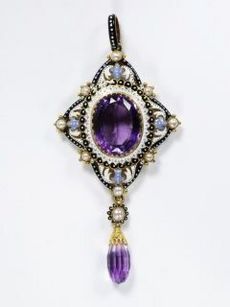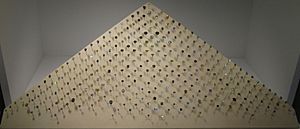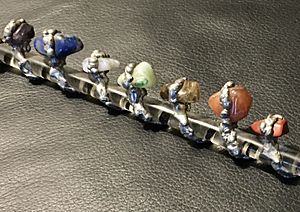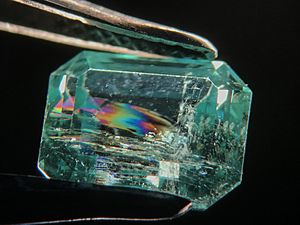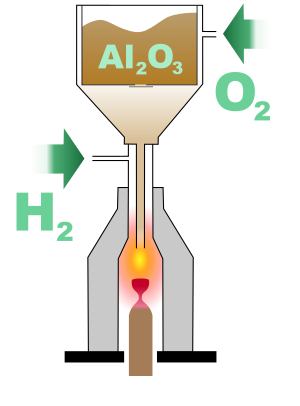Gemstone facts for kids
A gemstone is a special piece of mineral crystal. When it's cut and polished, people use it to make beautiful jewelry or other decorations. Some rocks like lapis lazuli or opal, and even natural materials like amber or pearls, are also called gemstones. Most gemstones are hard, but some softer ones are still used because of their amazing color or shine. A person who studies gems is called a gemologist. Someone who cuts and shapes gems is a lapidarist or gemcutter. A diamond cutter has a special name: a diamantaire.
Contents
What makes a gemstone special?
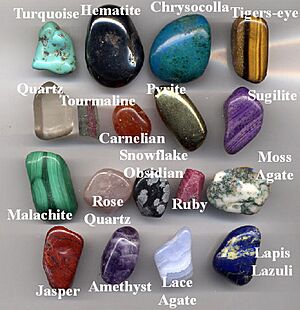
For a long time, people in the West called some gemstones "precious" and others "semi-precious." The "precious" ones were emeralds, rubies, sapphires, and diamonds. This was because they were rare and very hard. They also had beautiful, clear colors (except for diamonds, which are usually clear).
Today, gem experts, called gemologists, use more scientific ways to identify gemstones. They look at things like:
- Chemical Makeup: What elements is the gem made of? For example, diamonds are pure carbon, and rubies are made of aluminium oxide.
- Crystal System: How are the atoms arranged inside the gem? This creates different shapes, like cubes or triangles.
- Habit: What shape does the gem usually have when it's found in nature? Diamonds, for instance, often look like two pyramids joined at their bases.
How gemstones are grouped
Gemstones are sorted into groups, species, and varieties. Think of it like a family tree!
- Species: This is the main type of mineral. For example, corundum is a mineral species.
- Variety: This is a specific color or type within a species. A red corundum is called a ruby. Any other color of corundum (like blue, yellow, or pink) is called a sapphire.
- Group: Sometimes, several species are similar enough to be in the same group. The beryl group includes emerald (green), aquamarine (blue), and morganite (pink).
How gemologists describe gems
Gemologists look at many features to describe a gemstone:
- Color: This includes the main color, how light or dark it is, and how strong the color is.
- Luster: How shiny or reflective is the gem's surface?
- Refractive Index: How much does light bend when it passes through the gem? This affects its sparkle.
- Hardness: How resistant is the gem to scratching? This is measured on the Mohs scale. Diamonds are the hardest at 10.
- Clarity: How clear is the gem? Does it have any tiny marks or bits inside called inclusions?
- Optical Effects: Some gems show special light effects, like a star shape (called asteria) or different colors when viewed from different angles (called pleochroism).
How gemstone value is decided
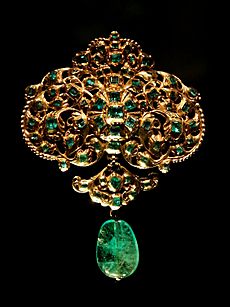
There isn't one simple way to grade all gemstones. For diamonds, experts use a system from the Gemological Institute of America (GIA). This system uses 10x magnification to check clarity. For other colored gemstones, experts usually use their eyes.
A helpful way to remember what makes a diamond valuable is the "four Cs":
- Color: How colorless (for white diamonds) or pure the color is (for colored diamonds).
- Cut: How well the gem is shaped and polished. A good cut makes a diamond sparkle and reflect light beautifully.
- Clarity: How few inclusions (tiny flaws inside) or blemishes (marks on the surface) the gem has.
- Carats: This is the weight of the gem. One carat is about 0.2 grams.
For colored gemstones like rubies or emeralds, the most important "C" is usually color. The purer and more beautiful the color, the more valuable the stone. Clarity is still important, but some gems, like emeralds, often have natural inclusions.
Some gemstones that were once considered "precious" like amethyst are now more common because large deposits were found. Today, many different gemstones are used in expensive jewelry, depending on fashion and demand. However, diamonds, rubies, sapphires, and emeralds still have a very high reputation.
Some gemstones are extremely rare and known mostly by collectors. These include painite, tanzanite, red beryl, and black opal.
The price of a gemstone depends on its quality, how rare it is, how beautiful it looks, and how much people want it.
Gemstone testing and reports
Many special laboratories around the world test gemstones and provide reports about them. These reports tell you about the gem's quality and characteristics. Some well-known labs include:
- Gemological Institute of America (GIA)
- International Gemological Institute (IGI)
- HRD Antwerp (The Diamond High Council)
- Swiss Gemmological Institute (SSEF)
- Gübelin Gem Lab
Each lab has its own way of checking gems. Sometimes, one lab might call a stone "pink," while another calls it "padparadscha" (a rare orange-pink sapphire). To make things more consistent, some of the top labs work together to standardize their reports.
How gemstones are cut and polished
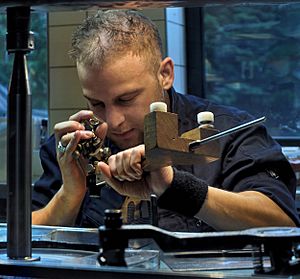
Most gemstones are cut and polished to make them ready for jewelry. There are two main ways this is done:
- Cabochons: These are smooth, dome-shaped stones. They are often used for opaque (not see-through) or semi-opaque gems like opal or turquoise. Cabochons show off the gem's color and surface shine. Grinding wheels and polishing tools are used to create their smooth, rounded shape.
- Faceted Stones: These gems have many small, flat, polished surfaces called facets. Faceting is usually done for transparent (see-through) gems. The facets are cut at exact angles to make the gem sparkle by reflecting light from its inside. If the angles are wrong, the light won't reflect properly, and the gem won't sparkle as much. A special machine called a faceting machine holds the stone while the facets are cut and polished.
The amazing colors of gemstones
The color of any material comes from light. White light (like daylight) contains all the colors of the rainbow. When light hits a gemstone, the gem absorbs most colors but reflects a specific one. The color that is reflected is the color we see. So, a ruby looks red because it absorbs all other colors and reflects red light.
Sometimes, gems that are mostly the same can have different colors. For example, rubies and sapphires are both types of corundum. They have the same basic chemical makeup. But tiny amounts of different impurities (other atoms) inside them absorb and reflect light differently.
- A pure beryl mineral is colorless.
- If it has chromium impurities, it becomes a green emerald.
- If it has manganese, it becomes a pink morganite.
- If it has iron, it becomes a blue aquamarine.
These impurities are often very small, sometimes just one in a million atoms, but they are enough to change the gem's color!
How gemstones are treated
Gemstones are often treated to make their color or clarity better. Sometimes, treatments can even make a gem stronger. These treatments can change the value of the stone. Some treatments are very common and accepted, while others are not because the color might not last.
Old ways of treating gems
Even thousands of years ago, people used techniques to improve gemstones. In ancient times, people would use metal foil behind a gem to make its color look better. The Roman writer Pliny the Elder wrote about oiling and dyeing gems 2,000 years ago.
Heat treatment
Heat can make a gemstone's color or clarity better, or sometimes worse. Heating gems has been known for centuries.
- Most citrine (yellow quartz) is made by heating amethyst (purple quartz).
- Aquamarine is often heated to remove yellow tones or to make its blue color deeper.
- Almost all tanzanite is heated to remove brown colors and give it a beautiful blue or purple shade.
- Many sapphires and rubies are heated to improve their color and clarity.
Radiation treatment
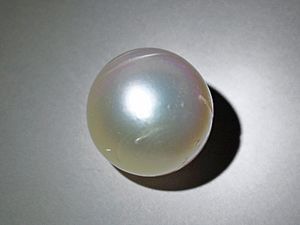
Radiation can change a gem's color. This process is common in the jewelry industry. For example, almost all blue topaz gets its color from being irradiated. Diamonds can also be irradiated to become blue-green or green. Sometimes, if gems are treated in a nuclear reactor, they can become slightly radioactive, so governments have rules about this.
Waxing and oiling
Emeralds often have natural cracks. Sometimes, these cracks are filled with wax or oil to make them less noticeable and improve the gem's color and clarity. Turquoise is also treated this way.
Fracture filling
This treatment fills cracks in gems like diamonds, emeralds, and sapphires. In 2006, "glass-filled rubies" became well-known. Large rubies with big cracks were filled with lead glass, which made them look much better. These treatments are usually easy to spot.
Bleaching
Bleaching uses chemicals to lighten a gem's color. After bleaching, a gem might be dyed a new color. Hydrogen peroxide is often used to treat gems like jade and pearls. Bleaching can also be followed by a process that makes the gem more durable.
Man-made and fake gemstones
It's important to know the difference between man-made (synthetic) gems and fake (imitation) gems.
- Synthetic Gems: These are created in a lab, but they are exactly the same as natural stones in every way: chemically, physically, and optically. They are real gems, just not from the Earth. Examples include lab-made diamonds, rubies, sapphires, and emeralds. Lab-created gems often have more vivid colors because they don't have the natural impurities found in Earth-mined stones.
- Imitation or Simulated Gems: These stones look like natural gems but are made of different materials. They are not chemically or physically the same. Examples include cubic zirconia (which looks like diamond but is made of zirconium oxide) or glass. They imitate the look but don't have the same properties.
How synthetic gems are made
There are several ways to create synthetic gems in a lab:
Verneuil flame fusion process
This was the first successful method to create large amounts of synthetic gemstones. It's still the most common way to make synthetic corundum (rubies and sapphires). In a special furnace, a fine powder of chemicals (like aluminum powder for corundum) is melted in a very hot flame. The melted drops fall onto a plate and cool down to form a crystal called a boule. This process takes hours and creates a crystal that is identical to its natural twin. Different chemicals are added to get different colors, like chromic oxide for ruby or iron and titanium oxide for blue sapphire.
Czochralski process
In this method, the gem materials are melted in a container. A small "seed" crystal is dipped into the melt and slowly pulled out. As it's pulled, the gem material crystallizes onto the seed, growing a larger gem.
Flux growth
This process is used to make synthetic beryls, like emeralds. The gem ingredients are dissolved in a special molten liquid called "flux" inside a crucible. As the liquid cools slowly, the gem crystals form. This process is much slower, sometimes taking months.
Hydrothermal growth
This method tries to copy how gems grow in nature. The gem materials are sealed in a container with water and placed under extreme pressure and heat. The hot water dissolves the materials, and they then crystallize onto a "seed" stone. This process takes a few weeks.
How to spot a synthetic gem
Even though synthetic gems are chemically the same as natural ones, gemologists can often tell them apart by looking for tiny clues under a microscope. These clues depend on how the gem was made:
- Gems made by flame fusion might have tiny air bubbles or curved growth lines.
- Gems made by flux growth might have small cavities filled with the flux liquid.
- Gems made by hydrothermal growth might have tiny inclusions from the container they grew in.
History of synthetic gems
Before synthetic gems, people only had imitations. In 1837, a French chemist named Marc Gaudin made tiny ruby crystals. Later, Auguste Verneuil developed the flame-fusion process in 1902. His method could produce large amounts of corundum efficiently, which changed the gemstone market a lot. Today, billions of carats of synthetic corundum are produced each year using this method.
Some very rare gemstones
Here are a few gemstones that are incredibly rare and special:
- Painite: Discovered in Myanmar in 1956, it was once thought to be the rarest mineral on Earth.
- Tanzanite: Found in Tanzania in 1967. Its supply might run out in the next 30 years, making it rarer than a diamond. It gets its vibrant blue color from being heated.
- Hibonite: Discovered in Madagascar in 1956. Gem-quality hibonite has only been found in Myanmar.
- Red beryl: Also called bixbite, it was found in Utah, USA, in 1904.
- Jeremejevite: Discovered in Russia in 1883.
- Taaffeite: Discovered in 1945.
- Musgravite: Discovered in Australia in 1967.
- Black opal: Mined in Australia, it's the rarest type of opal. It has a dark body color with amazing flashes of rainbow colors.
- Grandidierite: Discovered in Madagascar in 1902.
- Poudretteite: Discovered in Canada in 1965.
- Serendibite: Discovered in Sri Lanka in 1902.
- Zektzerite: Discovered in Washington, USA, in 1968.
See also
 In Spanish: Gema para niños
In Spanish: Gema para niños
- Gemology
- List of gemstones by species
- List of individual gemstones
- Luminous gemstones


